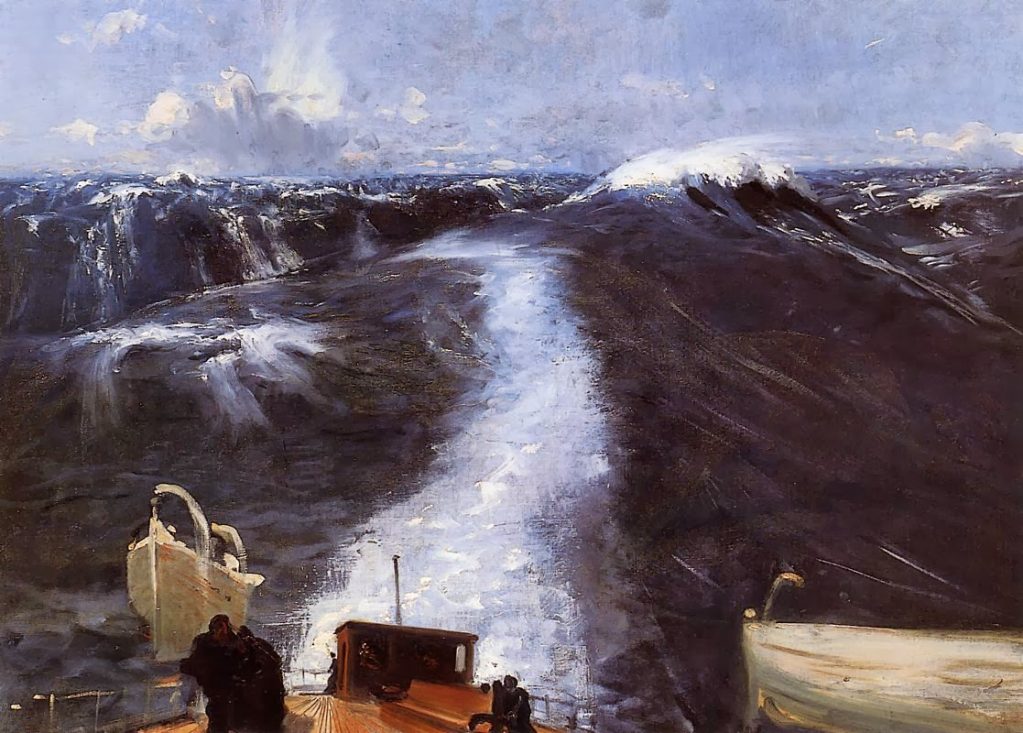The brilliant portraitist John Singer Sargent honed his craft by painting the sea
There’s a little-known side to the 19th-century American artist John Singer Sargent, and it is as far removed from the razzle-dazzle of his glittering career as a high-society portraitist as you can imagine.
The artist who was famously described by Rodin as “the Van Dyck of our times” started his career emulating that great master of the seas, J M W Turner. He diligently honed his craft by painting dramatic seascapes, gentle coastlines and noble fishing folk. And if the 20-year-old Sargent couldn’t quite manage the roiling waves and lowering skies with quite the same level of brilliance as the English painter, he nonetheless possessed a quite remarkable artistic maturity. Turner, by contrast, could never quite paint a convincing human figure.
Born in Florence to Europhile, expat parents, Sargent’s early life seemed to consist of one perpetual grand European tour: France, Germany, Italy, Switzerland, all provided temporary homes for the cultured and quadralingual young artist. But it was the artistic centre of Paris that remained a base. And although his father had hoped for a naval career for his son – a love of ships and the sea, as well as of boisterous adventure, evident from an early age – Sargent remained in Paris to pursue his artistic training. Degas, Monet and Whistler would become artists to emulate, though clearly it was a boyhood passion for the drama of the waves that Turner, Sargent’s first great inspiration, satisfied.
he Royal Academy’s illuminating exhibition begins in 1874, with Sargent aged just 18. It focuses on the five years that he worked diligently on his marine paintings, painting and sketching first on the Normandy and Brittany coasts, then in Capri and various Mediterranean ports. It is the year of the Impressionist’s first exhibition, but Sargent would have known little if anything at all of this avant-garde movement. His own paintings are denser, darker, more polished, in the Salon style, but with touches of the bravura brilliance that would seduce and dazzle in his later portraits.
It would be a full 10 years before his most famous painting, the portrait of that bare shouldered siren Madame X, would scandalise Parisian high society, making a scarlet woman of its subject and persuading Sargent to leave Paris for London for good. (Perhaps, finding that success had come too easily, and not immune to the charges of superficiality that his glamorous portraits excited, he later condemned portraiture as “a pimp’s profession” and returned to his safe and beloved coastal scenes.)
But this was all to come. Here, a sketch of a shipwreck in 1876, shows an exuberant copy of Turner’s 1805 painting of that name, while, in Atlantic Storm, c 1876, the vertiginous dip of a steamship’s deck as it makes its way through the high seas, was painted while Sargent was crossing the Atlantic for the first time to visit America. Two shadowy passengers attempt to make their way up the sloping deck – the precocious Sargent always had an eye for narrative drama.
There is, of course, little to scandalise here, though we might easily detect a hint of the homoerotic in Sargent’s Capri paintings of carefree Neapolitan boys bathing nude. But, apart from those displayed in a few notebook sketches, his first few years show surprisingly little interest in the human figure. Instead we find sketches of marine life: a painting executed in dark brown hues of two glistening octopi, tentacles entwined; tumultuous seas unbounded by land, with a ship tossed by waves viewed at a distance, so that we may be awed by the power of nature; and quiet little harbours with sailing boats all at anchor.
What may seem surprising is that Sargent painted the working coast, not the newly popular resorts and fashionable promenades bought to vivid life by the fresh palette of the Impressionists. And, like Millet, Sargent’s ordinary working folk, particularly in his large-scale En Route pour la pêche, 1878, possess an idealised dignity: far from the fleeting impression, he attempts to give a sense of monumentality to ordinary human endeavour. In doing so, his paintings of oyster catchers in Cancale, on the Brittany Coast, are Sargent’s greatest achievement of this period. Knowing just how to arrange these figures in relation to one another, our eyes are drawn in, captivated by the whole. Finally he has focused on the human.
His palette was to brighten, his paintwork to achieve a more impressionistic looseness, but here is where it started. One can catch glimpses of his greatness right here.

